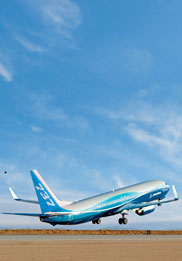

Every takeoff is an opportunity to save fuel. If each takeoff and climb is performed efficiently, an airline can realize significant savings over time. But what constitutes an efficient takeoff? How should a climb be executed for maximum fuel savings? The most efficient flights actually begin long before the airplane is cleared for takeoff.
THE DIFFERENCE BETWEEN HIGHER AND LOWER FLAP SETTING CONFIGURATIONS MAY SEEM SMALL, BUT AT TODAY'S FUEL PRICES THE SAVINGS CAN BE SUBSTANTIAL.
By William Roberson, Senior Safety Pilot, Flight Operations; and James A. Johns, Flight Operations Engineer, Flight Operations Engineering
This article is the third in a series exploring fuel conservation strategies.
This article discusses strategies for fuel savings during the takeoff and climb phases of flight. Subsequent articles in this series will deal with the descent, approach, and landing phases of flight, as well as auxiliary-power-unit usage strategies. The first article in this series, “Cost Index Explained,” appeared in the second-quarter 2007 AERO. It was followed by “Cruise Flight” in the fourth-quarter 2007 issue.
Takeoff and climb fuel conservation strategies
In the past, when the price of jet fuel increased by 20 to 30 cents per U.S. gallon, airlines did not concern themselves with fuel conservation in the takeoff and climb segment of the flight because it represents only 8 to 15 percent of the total time of a medium- to long-range flight.
But times have clearly changed. Jet fuel prices have increased over five times from 1990 to 2008. At this time, fuel is about 40 percent of a typical airline’s total operating cost. As a result, airlines are reviewing all phases of flight to determine how fuel burn savings can be gained in each phase and in total.
This article examines the takeoff and climb phase for four types of commercial airplanes to illustrate various takeoff and climb scenarios and how they impact fuel usage. These analyses look at short-range (e.g., 717), medium-range (e.g., 737-800 with winglets), and long-range (e.g., 777-200 Extended Range and 747-400) airplanes.
An important consideration when seeking fuel savings in the takeoff and climb phase of flight is the takeoff flap setting. The lower the flap setting, the lower the drag, resulting in less fuel burned. Figure 1 shows the effect of takeoff flap setting on fuel burn from brake release to a pressure altitude of 10,000 feet (3,048 meters), assuming an acceleration altitude of 3,000 feet (914 meters) above ground level (AGL). In all cases, however, the flap setting must be appropriate for the situation to ensure airplane safety.
IMPACT OF TAKEOFF FLAPS SELECTION
ON FUEL BURN
Figure 1
| Airplane Model |
Takeoff Flap Setting |
Takeoff Gross WeightPounds (kilograms) |
Fuel Used Pounds (kilograms) |
Fuel Differential Pounds (kilograms) |
5 |
933 (423) |
- |
||
| 717-200 | 13 |
113,000 (51,256) |
950 (431) |
17 (8) |
18 |
965 (438) |
32 (15) |
||
5 |
1,274 (578) |
- |
||
| 737-800 Winglets | 10 |
160,000 (72,575) |
1,291 (586) |
17 (8) |
15 |
1,297 (588) |
23 (10) |
||
5 |
3,605 (1,635) |
- |
||
| 777-200 Extended Range | 10 |
555,000 (249,476) |
3,677 (1,668) |
72 (33) |
20 |
3,730 (1,692) |
125 (57) |
||
| 747-400 | 10 |
725,000 (328,855) |
5,633 (2,555) |
- |
20 |
5,772 (2,618) |
139 (63) |
||
| 747-400 Freighter | 10 |
790,000 (358,338) |
6,389 (2,898) |
- |
20 |
6,539 (2,966) |
150 (68) |
Higher flap setting configurations use more fuel than lower flap configurations. The difference is small, but at today’s prices the savings can be substantial — especially for airplanes that fly a high number of cycles each day.
For example, an operator with a small fleet of 717s which flies approximately 10 total cycles per day could save 320 pounds (145 kilograms) of fuel per day by changing its normal takeoff flaps setting from 18 to 5 degrees. With a fuel price of US$3.70 per U.S. gallon, this would be approximately US$175 per day. Assuming each airplane is flown 350 days per year, the airline could save approximately US$61,000 a year. If an airline makes this change to a fleet of 717 airplanes that averages 200 cycles a day, it could save more than US$1 million per year in fuel costs.

